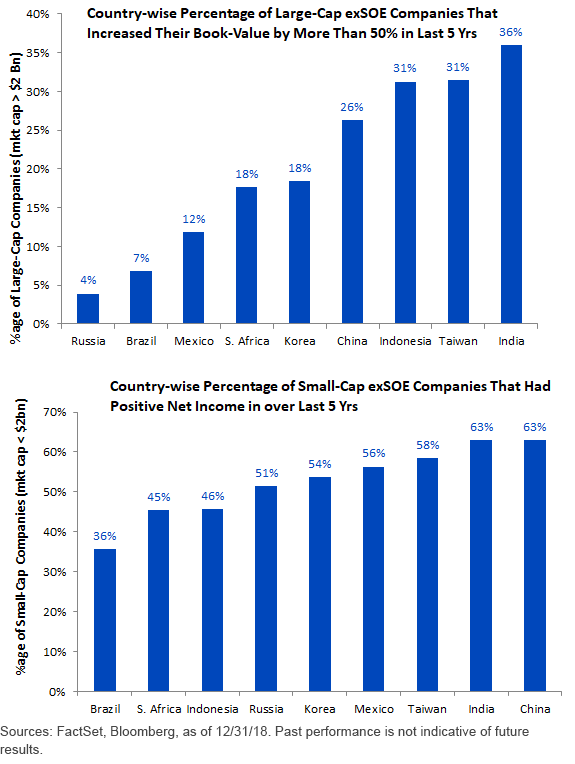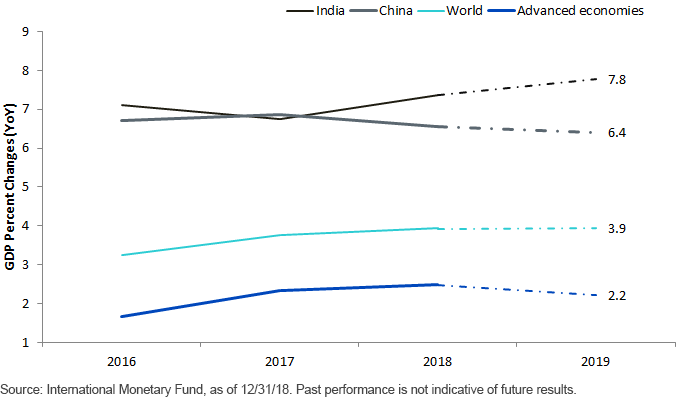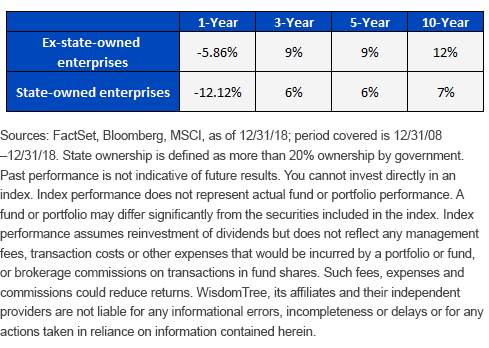Look at the irony of the emerging market (EM) equities.
When the American economy stalls, they tend to take the heat since America is the largest market for EM products.1 But when the American economy booms, EM equities can still suffer if the Federal Reserve (Fed) hikes rates too fast. Last year is the best example.
After volatile U.S. equity markets last year and low inflation, many believe the Fed may take a softer course this year. This may come as good news to EM equities, which currently have attractive valuations after taking a hit in 2018.
So, is this the right time to allocate to EM equities?
The answer is nuanced: when investing in EM, investors may want to focus on countries with higher economic growth and apply smart security selection to select stocks within those markets.
Fast Economies Lead to Faster Corporate Growth
Below, we look at ex-state-owned enterprises (ex-SOEs), both large and small caps, to identify places where maximum growth has happened. We define any company as ex-SOE where the state has less than 20% ownership. Our goal is to identify growth and profitability with minimal state interventions.
The first chart below is the proportion of large-cap ex-SOEs (market cap greater than $2 billion) that show book value growth of more than 50% over the last five years. The second chart is the proportion of small caps (market cap less than $2 billion) ex-SOEs with positive cash flows over the last five years.

A quick observation: Indian, Chinese and Taiwanese companies consistently fared better across large and small caps. Next, let’s look at what may have helped these companies.
Economic Growth Feeding Corporate Growth
To explore one reason why certain countries did better than others, look at a simple chart of gross domestic product (GDP) growth trends projected by the International Monetary Fund.
GDP Growth Rates (Past and Projected)

If you juxtapose this chart with the corporate profit growth above, there are two takeaways:
- Countries such as India and China, which grew nearly twice as fast as the rest of the world, provided a massive tailwind to their large-cap companies.
- As the economy picked up and growth percolated throughout the economy, small-cap companies, which are typically tied more strongly to local consumption, benefited and made more profits.
A few thoughts about all of this:
- Strategic investors may want to be over-weight in fast-growing countries, such as India and China.
- And while economic growth is a function of many factors, including government policy, ex-SOEs can benefit not just from the faster economic growth but from profit-centric policies of a lean management, promoting some of the biggest capture of economic tailwinds.
Investing in Ex-State-Owned Enterprises
While India can offer an excellent growth opportunity, EM institutions are often fragile. This poses the unique challenge of tapping into efficiently run firms but avoiding inefficient firms that could suffer more if sentiments were to change. To help solve for this problem, we just expanded our ex-state-owned EM suite, launching the WisdomTree India ex-State-Owned Enterprises Fund (IXSE), which tracks the WisdomTree India ex-State-Owned Enterprises Index (INXSOE).
INXSOE removes any company with greater than 20% government ownership and thus focuses more on the private and consumer economy, tapping into the real growth of India’s rising middle class and privately held sector.
Beyond just profits and book values as shown by exhibits above, the table below reflects how meaningfully different the stock performance of state and ex-state-owned companies could be.
Annualized Returns of ex-State-Owned vs. State Owned Entities in MSCI India Index

IXSE marks another milestone in our continual effort to offer investors enhanced exposures with unique stock selection methodology and expands our existing suite of ex-state-owned strategies within the emerging markets. We believe by allocating to IXSE, investors can potentially benefit from the exceptional growth that the private sector of India’s economy can offer.
1Sources: World Bank, IMF, s of 12/31/18.



